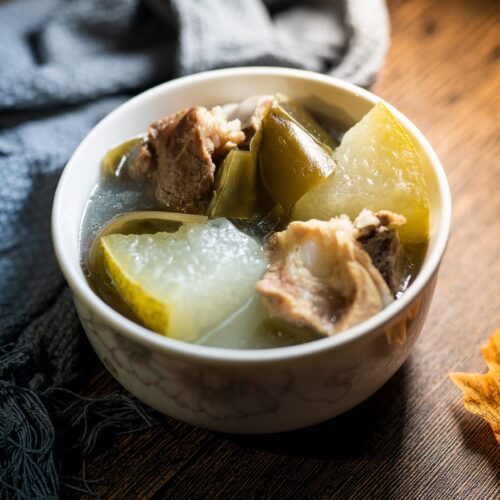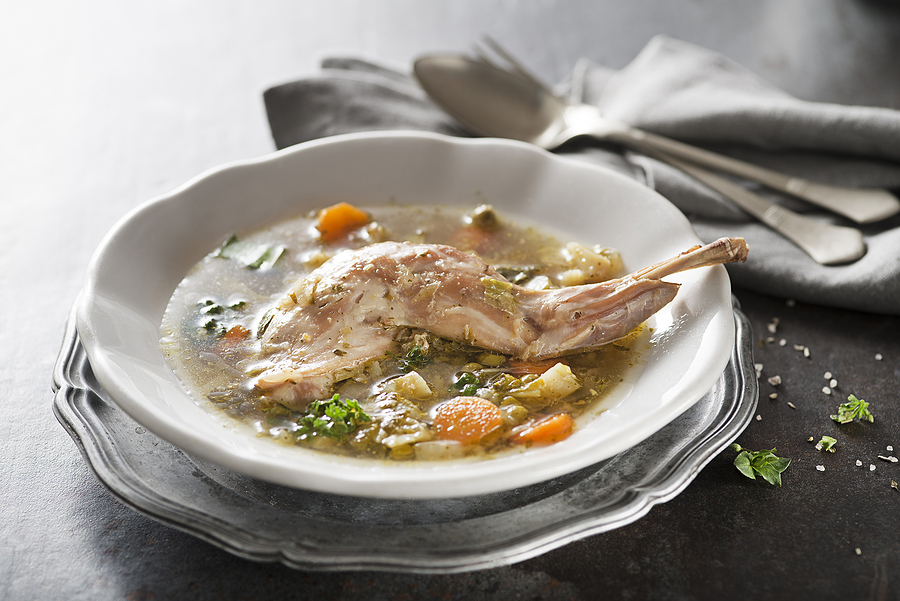Sinigang is a common sight at Filipino meals. The stew encompasses various easily customizable ingredients depending on the preferred taste. This Sinigang recipe takes about an hour to prepare and cook, featuring pork belly and traditional vegetables with shishito peppers for a heated flavour.
There is nothing more popular than a warm bowl of Sinigang among Filipinos. In recent times, it has gained popularity across other households, too. What’s not to love? Savoury stew with succulent pork is the best way to get your tastebuds singing.
There are multiple variations of the stew, which only sometimes include pork. You can add various vegetables and proteins to create dynamic flavours.
However, in today’s recipe, we will make the pork Sinigang—a true classic. Here’s everything you need to know to create a stewed dish no one can shut up about.
Sinigang Recipe

Equipment
- Chopping boards
Ingredients
- 900 grams Pork belly, chopped into 1-inch cubes
- 0.11 grams Green beans, cut into 2-inch pieces
- 0.11 grams Okra
- 140 grams Daikon radish, sliced into small discs
- 6 Shishito peppers
- 1 Roma tomato, sliced into eighths
- 1 Onion, sliced into wedges
- 1 Eggplant, sliced into 1-inch pieces
- 1/2 cup Tamarind concentrate
- 8 cups Water
- 3 tablespoons Vegetable or any cooking oil
- Fish sauce
- Salt
- Ground black pepper
Method
- Chop: Before you can get your stew on the stove, you will need to ready your ingredients. Set out everything on the table. Wash and clean your pork meat and vegetables.
- Begin to slice and cut the ingredients. Chop the pork meat into 1-inch cubes. Slice the eggplant and green beans into 1-inch and 2-inch pieces, respectively. Take off the tops of the okra.
- Slice the tomato into eighths and wedge the onion. Take your daikon radishes and chop them into small discs.
- Sauté: Now, it is time to move on to the next phase—cooking. Add three tablespoons of oil to a cooking pot and heat it. Drop your chopped onion into the heated oil and sauté it until the layers start to separate. Next, add half of the tomato and allow it to soften for about two minutes.
- Add the peppers. Follow it with your cubed pork meat once the mixture softens and gets aromatic. Allow the meat to brown evenly. Mix one tablespoon of fish sauce into the pot. Sauté for a couple of minutes.
- Simmer: Pour all the cups of water into the pot. Bring it to a boil. Once the liquid is boiling, add the tamarind concentrate. Continue to cook the sinigang on low or medium heat for about 30 minutes or until the meat becomes tender.
- Add Vegetables and Season: The final step involves tossing the okra and eggplant into the stew. Cover the pot and allow it to simmer for five minutes. Add the radishes and green beans and cook for an additional three minutes. Add the remaining tomato and allow it to soften. Season as per your taste.
- Give it one last boil to allow all your ingredients to harmonize with each other, then turn off the heat.
- Keep the Fish Sauce Handy: When you serve the sinigang at the table, make sure to accompany it with additional fish sauce in case anyone requires more flavour.
- Use Rice Water: Some people like to use rice water instead of plain water to give body to the soup. It is highly nutritional and does not impact the classic sinigang taste.
- Experiment with a Souring Agent: You can try different souring agents. The most commonly used are sour fruits like pineapple, kamias, kalamansi and batuan.
If you are sticking to the tamarind pulp, make sure you choose the sour variety over the sweet variety that is more commonly available. - Adjust the Heat Level: Shishito peppers have a mild heat level. However, sometimes, a few peppers can pack serious heat. If you cannot tolerate a lot of heat, you can take out its seeds before you add them to the sinigan.
FAQ
What Are The Main Ingredients Of Sinigang?
Sinigang is a native Filipino dish. The stewed dish is prepared by simmering and blending together unique flavours of tender meat, tomatoes, fish sauce and a desired combination of vegetables like okra, fresh spinach, string beans, etc.
Every region has its own recipe for sinigang, each poignant and powerful in its flavour.
Can you substitute fish for pork in Sinigang?
The delicious sour broth can be prepared with pork, beef, and seafood. If you want to skip pork in your sinigang, you can make it with fish. However, it is never made with chicken.
You can choose between tilapia, bangus or salmon—the seafood choices are abundant. Adding a crunch to your fish can make your soup more unique. Lightly fry the fish in a pan or air before adding it to the Sinigang.
Can You Substitute Tomato In Sinigang?
You can go for pre-packaged tomato sauce if you are out of fresh tomatoes. However, you will miss out on the classic taste that the fresh tomatoes bring to the bowl. You can also try canned tomatoes or use red bell pepper as a stand-in.
If you are out of all the alternatives or cannot consume tomatoes for some reason, you can leave them out entirely.
Summary
Sinigang makes a delicious accompaniment to rice. Although it is typically cooked during special occasions, it is quite favoured for everyday meals. This Filipino dish comprises meat or seafood with sour flavouring and various vegetables. Its sweet and savoury flavour is a delight to the tastebuds.
It is easy to prepare. The prep time is a mere 10 minutes, while the rest of the 50 minutes involve light sauteéing and simmering. You can make certain substitutions if you do not have all the ingredients, making the dish an appealing addition to everyday meals.



